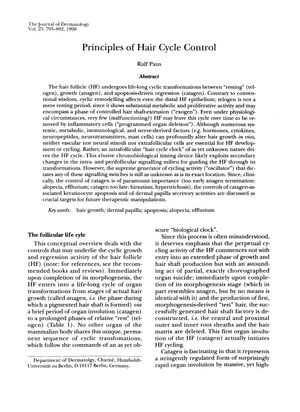Principles of Hair Cycle Control
December 1998
in “
The Journal of Dermatology
”
hair follicle hair cycle clock catagen phase alopecia hirsutism hypertrichosis programmed organ deletion anagen-catagen transformation oscillator system HF cycling intracellular gene expression local signaling hair growth management telogen phase topical treatments hair follicle hair cycle clock catagen phase hair loss excessive hair growth programmed organ deletion hair growth cycle gene expression local signaling hair growth management resting phase topical treatments

TLDR Manipulating the catagen and telogen phases of hair growth could lead to treatments for hair disorders.
The 1998 document outlines the principles of hair follicle (HF) cycling, emphasizing the importance of the intrafollicular "hair cycle clock" in controlling the hair cycle independently of external stimuli. It discusses the significance of the catagen phase in hair disorders, suggesting that premature termination can lead to alopecia, while delayed catagen can cause hirsutism or hypertrichosis. The paper also introduces the concept of "programmed organ deletion" as a possible explanation for the decrease in HF density with age. It highlights the need for research into the control of the anagen-catagen transformation and the identification of the "oscillator" system that dictates HF cycling. The document suggests that murine models are valuable for hair research and that understanding intrafollicular gene expression and local signaling is crucial for developing effective hair growth management treatments. It concludes that manipulating the catagen and telogen phases could be key in treating hair growth disorders, with the potential for topical treatments to play a significant role in managing these conditions.

